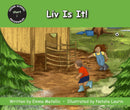Description
Welcome to Cedar School! Join Liv, Tom, Gus, and Bell as they learn on the land and explore Mi’gmaw teachings with their teacher, Miss Sam, and the school’s Mi’gmaw Elder, Jen. With charming illustrations and simple storylines, this decodable series engages students as they practise their reading skills. Each book includes a pre-reading review of non-decodable words, and many of the books introduce special words related to Indigenous teachings. Talking Together prompts facilitate discussions led by the reading teacher.
Developed in partnership with Dyslexia Canada, Cedar School Decodables is a series of 20 decodable books for young readers. Designed for students who have previously learned short vowel and consonant sounds, additional phonic skills are developed progressively throughout the series. Cedar School Decodables is divided into six sets, which increase in word count and complexity of sentence structure:
Set 1 – Short Vowels (40-60 words)
Set 2 – Digraphs (60-80 words)
Set 3 – VCe (80-90 words)
Set 4 – Longer Words (90-100 words)
Set 5 – Ending Spelling Patterns (100-110 words)
Set 6 – R-Controlled Vowels (110-125 words)
Educator Information
The bundle includes 20 books, one copy of each title in the Cedar School Decodables series.
This series is recommended for ages 4 to 7 for use in kindergarten and Grade 1 classrooms.
This series is accompanied by Cedar School Stories, a set of four picture books that expand on the friends’ adventures. Each read-aloud story can be read on its own or alongside the decodable series to enhance learning. Mi’gmaw language is included in each book, along with a pronunciation and translation guide and additional educator information.
Written by Emma Metallic, Mi'kmaq (Mi'gmaq) from Listuguj Mi'gmaq First Nation, and illustrated by Natalie Laurin, Métis.
Set 1 – Short Vowels (40-60 words)
Cedar School Decodables: Liv Is It!
Liv Is It! is in Set 1 – Short Vowels, and reviews short i.
In this story, Tom and Liv play tag in the forest. They run and hide among cedar, birch, and maple trees.
Cedar is a traditional medicine tree for Mi’gmaq. Birch bark is used by Mi’gmaq to make many things, including canoes and moose callers. Traditionally, Mi’gmaq used birch bark bowls to collect maple sap.
What kind of trees grow where you live?
More Educator Information
Readers should be familiar with the concepts included in Set 1:
consonants
beginning and end blends
short vowels
s – /s/ and /z/
-s suffix




